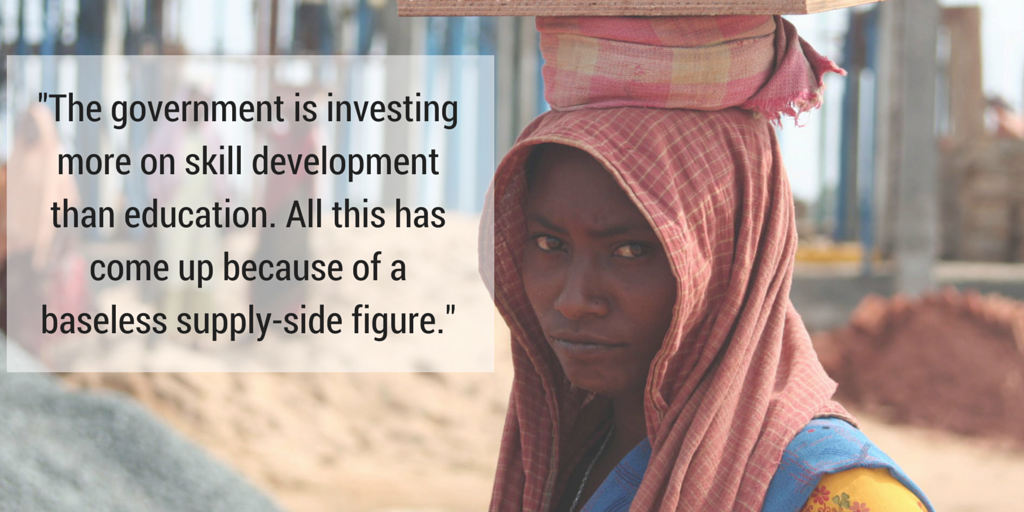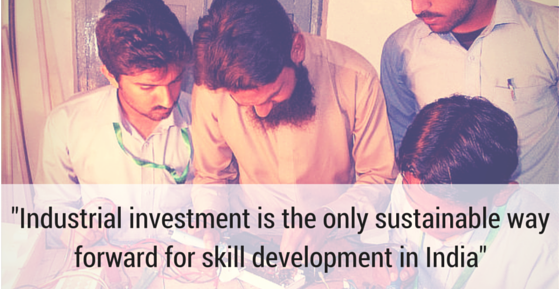Skill development in India has become a key focus area for the new government. The Ministry of Skill Development and Entrepreneurship was created in 2014, and in July the Prime Minister launched the Skill India mission, which is targeting 40 crore workers by 2022. However the massive drive to expand vocational training has come into criticism from those who claim that the demand for skilling has been overestimated, and that separating skilling from education is a flawed model.
Radhika M. Chakraborty from SHRAM interviewed Prerit Rana, Co-founder and CEO of SHRAM Partner Agrasar, to discuss the issue of skill development for the youth, the way forward for sustainable skill development models, and the merits and flaws of the Skill India Mission.
Agrasar is a non-profit organization working in the field of human capital development and social security of the disadvantaged communities in India. Established in Dec 2010, the organization is primarily working on three inter-related developmental themes: Education, Employability, and Social Security.
Let’s start with talking about your views on skilling; could you share with us your skilling philosophy, and Agrasar’s role?
We started Agrasar at a time when the National Skill Development policy had just come up (in 2009) and everyone was talking about skilling. We set up vocational training centres. We have five centres presently. At the beginning, at Agrasar I was involved in operations and mobilization.
The media has overstated the demand for vocational training.
But in the last three and a half years, looking at our work at Agrasar and the state of the development sector (I also serve as a consultant in several other places, and have thus seen what the industry is like), I can say that there is definitely a demand for vocational training, but not as much as highlighted in media. The media has overstated the demand, and I feel there is not as much of a demand as is being projected.
The Prime Minister today is talking about only two things, skill development and toilets. But this demand for vocational training is not what I see at the ground level, after lot of interaction with various stakeholders.
Therefore, at Agrasar we have decided we are not in a mode where we want to scale up. We want to experiment and design a programme which does something which very few centres are doing; making a significant impact in lives of the people who go to these centres.
Most skill development centres are becoming a part of a cheap supply chain for the industry. However the reality is that the industry recruits from vocational training centres primarily because of the convenience of this source of manpower, and not due to the skills they possess.
So what you’re saying is, there is a disconnect between the training being provided, and the kind of skills actually required, and the number of jobs available.
The late C.K. Prahlad came up with this in 2007, on the assumption of population growth; but we don’t have that many jobs, so training for so many does not make sense. My experiences from the field and new studies have suggested that it is definitely not 500 million. Also, no training is required for most of the roles in all kinds of industries. Employees learn on the job and companies are satisfied with that. However, they aim to get people with foundational employability skills–communication skills, inter-personal skills, learnability and retainability. This cannot be taught in a three month program, which is what mosttraining centres are trying to do. Effort has to be brought in at secondary education level. “Skill India” can never be a cure for the ailing education system of the country.
A lot of resources are getting devoted to skill development; I would say that the government is investing more on skill development than education. All of this has come up is because of this baseless figure.

Another disconnect is in term of quality. There are lots of examples for this. If you go look for example at the healthcare sector, there will be many jobs listed; with roles like dental assistant, physiotherapy assistant, and so on. But if you go to the big hospitals,recruitment does not happen separately for such profiles. They just want people to come on board as a general duty assistant, doing things like pulling a wheelchair, helping nurses. But while doing this, the smart ones will pick up a skill: they will learn to check blood pressure while on rounds… and so on. And, then they would enter into more specific roles.
So if you train someone in a field, it is not necessary they will get into it. Certain industries do not require domain specific knowledge. A major example of this is the retail sector: you do not require people to have domain specific knowledge; but basic employability skills. Those cannot be provided through vocational training. We do it, but I feel 3 months never does justice.
That means we have to move back to education. We must focus on these aspects at the level of education itself.
In recent years there has been a paradigm shift. People are thinking away from education. But if you look at people like us, we have become job ready mainly because of our schooling.
we have become job ready mainly because of our schooling and education.
Another important point is, our industry is structured in such a manner that we have very specific roles. For example you consider the role of mechanic in auto industry; he will be making only one specific part, or operating one machine, which requires only a specific skill. They are part of a mass production system. This is how roles are designed. So why should we train people in 100 competencies if they will just end up doing one task?
This understanding of mine is on the basis of experience of placing more than 2000 students at Agrasar and my interactions with companies, with stakeholders in the industry.
On SHRAM, we’ve explored the disconnect between skill development at the source end, and availability of jobs at the destination end: youth who migrate are often over qualified for the jobs they acquire in destinations cities- despite having qualifications, they end up in say, construction work.
Absolutely. I was at NSDA, the apex body on skilling, for a presentation. In the old office, all the people working on construction there, were regular “mazdoors”. There was no manpower from the vocational training sector! So, even the NSDA has not felt the need of hiring people from formal agencies.
According to you, what is the most sustainable approach to skilling, how do you envision the future of vocational training?
I would say there are two major things to be done.
1) To give a narrower but deeper focus to these efforts, and identify roles for which you definitely need domain specific skills to begin with. In the garment sector example: we have a program, we train people in machine operation. If you take the example of two people, one trained at our centre, and one untrained, and both join the garments company. They will both join at the same entry level position, but the one who is trained will get into the role of machine operator much sooner than the untrained one. However there is no documentation of this kind of patterns, which is really needed.
What is happening now is a lot of NGOs are doing things like retail sector training, hospitality, and so on. But I see that entry level training for these sectors does not make sense. They will hire on a first come first serve basis, for starters.
Foundational skills take much longer to develop, and require more consistent effort. So this you can do only at the education stage.
And another factor is;
2) All these roles are dependent on foundational skills. These cannot be provided in 3 month programs. We may be able to do some refining, but never able to do justice. These foundational skills take much longer to develop, and require more consistent effort. So this you can do only at the secondary education stage.
So you are saying that skill development must be taken into consideration at an earlier stage, during education.
Yes, foundational skills must be developed during education. However, it is important that this is but not very specific. They should be foundational skills; not specific vocational training skills. Some people want to start specific vocational training as early as Class 9. But that is not required; broad foundational skills are required.
We are in the roles we are, for example, because of our ability to communicate, and this is something we probably learnt through schooling.
So according to you, where exactly does the Skill India Mission falter?
Apart from what I’ve mentioned earlier, the point about the various disconnects, the Skill India mission has a very straight-jacketed approach to skill development. There are many roles for which training is not needed as per current scenario.
Either you influence the industry: say that we will influence HR, influence hiring policies, match the demand, create paradigms for benefits; and so on; but don’t just say you are training people and getting them placed. This is an incomplete picture.
Also, the industry is not investing at all. if this projected demand from the industry for skilled workers was so huge, would they not have invested?
The government has to look very critically at this issue.
So if the Skill India Mission’s approach is flawed, what do you think state intervention in youth skilling should look like?
See, one thing they should not have done, is to set up separate ministry for skill development. This should have been part of Human Resource Development department; and then it would have been linked to education.
Also, the government must look at the education system and see if people are getting employable through our schools. That is not happening. 3 months being enough for foundational skill development is a completely utopian view.
the government must look at the education system and see if people are getting employable through our schools
Skill development three month programs present something that is easily measurable; which is why they are so attractive for funding agencies. Because you present a certain number of enrollments, and say that look, these many got placed. Looking at placement figures does not really make any sense. If 100 people come to a centre, 80 would already be employable beforehand; because many industries just take people on a first come first serve basis, and train them themselves.
I’m not suggesting you do away with these programs; but we must give them proper focus. Its important to find programs that are really making an impact in these people’s lives.
Therefore the government should mandate all NSDC partners to answer the question: what would happen if they had not come to these centres? The government should force people to at least think about this question, and in the next few years, answer it.
What is the state of research on skill development?
This is something that really really needs to be taken up on major scale, and looked at in more critical terms. Otherwise the same story of what happened with microfinance, will happen with skill development.
Previously you’ve written about different, individual approaches and attitudes towards skill development. How do you think the youth sees the need to work? What are the connections between skill development and aspirations?
At Agrasar we have something called ‘The Staffroom’ Initiative, which is for uniting schools that work in Gurgaon, developing curriculum together, etc. At one of these session with a group of children, aged 14-18, we asked them: what do you want to become? One said, the Prime Minister, one said Ratan Tata. 15 out of 20 said we want to be our own boss. So you see they have very high aspirations.
This aspiration starts getting diluted when reality hits, and as they grow older. Another factor is that children don’t have any kind of orientation on kind of jobs that are available. this is very important, and is something they must be provided with.
What is the other work in the field of vocational training like in the current scenario? Are most NGOs following a supply chain model?
See there are two categories or organisations working on vocational training, for profit and non-profit. The for-profit institutions aim to generate income in the following ways: either they charge students, or they charge employers. The charging students approach failed completely (apart from a few exceptions), as there was no demand, and they realised students will not pay them.
The other approach, which I believe is the more sustainable one, is getting industrial investment. one example that comes to mind is Gram Tarang. But these are very few, exceptional models. Even at Agrasar we are trying to do this. We will set up a new centre only when the industry will invest. Until then we are happy with our five centres. Industry investment is the only way forward.
We have had some success in the garments sector. We have got machines from this company, Matrix Clothing, they have provided us with machinery which is very major; it is something we would never have been able to afford otherwise. And we are also not mandated to place students in that company, because they believe they are competitive enough that without this mandate too there will still be enough incentive for people to join them.
We previously had other proposals; but the kind of investment required was huge. But now we are in talks with a few new companies. And the cost per student has really come down. Essentially we are asking them: you give us the technical know-how and some infrastructure. We can design curriculum. And it is this approach that can take the initiative forward.
So you believe industrial involvement is key?
Not just involvement, but investment. Involvement can be minimal also; they could be on advisory committees, etc, but the real effect will come when they invest. This will be what bridges the disconnects; because if the industry is investing, it means they will invest because there is demand from their end. I believe this is the only sustainable way forward.
Radhika M. Chakraborty
Latest posts by Radhika M. Chakraborty (see all)
- The Drowned and the Saved - September 21, 2015
- Travelling terms: The semantics of migration discourse - September 3, 2015
- Legal literacy camp: PEPUS - August 25, 2015




 Posted in
Posted in  Tags:
Tags:
Interesting interview but it left me a bit confused. For instance, what is the skilling opportunity? Street experience says that skills such as carpentry, masonry, welding, and electricians are in short supply — try getting any of these guys and you’ll know! On the other hand, I see people in the MNREGA kind of programs who are doing the proverbial dig-a-hole-and-fill-it kind of low skill work that does not advance their future. Then again, schemes like Kudumbashree in Kerala are imparting solid skills to women.
Hi Vijay
“What is the Skilling opportunity” is THE question to answer! The problem is that most of the skill development agencies assumed an easy answers to this question and went full throttle without considering the socio-economic paradigm. The skilling sector is at a nascent stage if we consider 2009 Policy as the watershed event. So, a lot more research is needed. And, some experiments before we even talk about scale. So, this “confusion” will lead us towards justice someday.
Carpentry, Masonry, welding and electrician may not be as much a skilling problem as it is ingrained in macro economy. These are entrepreneurial roles and the key lies in developing entrepreneurial culture and support structure in the country. Even if he gets training, a migrant has two choices – 1. He gets into daily wage labour (construction site) or work in a factory in unskilled role. He would have some surety of income here. 2. He works as an electrician or a carpenter with high uncertainty of income. People migrate under distress and they choose option 1 mostly. That’s why we struggle to find electricians.
However, training for entrepreneurial role has to be explored more before coming to any conclusion. Kudumbashree is a great example. It is not ‘just a skill’ program and that’s its strength. It is an integrated program for entrepreneurial development. Credit and marketing support is as much a part of the program as is skilling.
MNREGA is unfortunately not a skilling program. It is more of a freebie stuff. I am not connected to MNREGA for last four years now. So, maybe somebody can have the most recent perspective.
Regards,
Prerit
Prerit, some of your views are backed up Pratham’s recent survey of skilled youth. http://qz.com/475874/why-indias-approach-to-its-unemployment-problem-is-wrong/
They are also focusing on the need to focus on strategies to make the transition into urban areas easier for rural youth. They mention rental housing, cooked food facilities, counseling and hand holding young people. =I would add toilets as well!
Perhaps there is a way to converge the PM’s declared priorities, but are our cities in a position to take this initiative? Will smart cities incorporate these very basic interventions that are very human as opposed to digital?